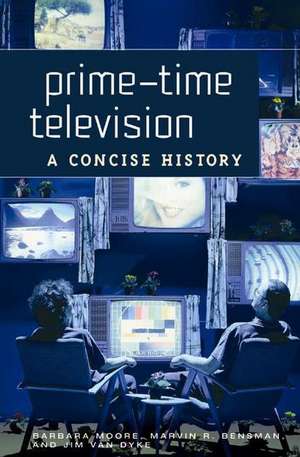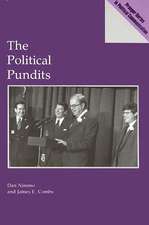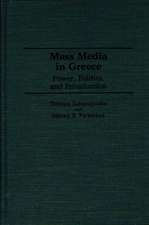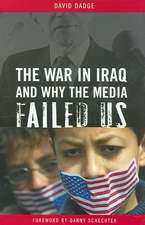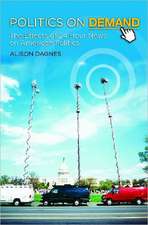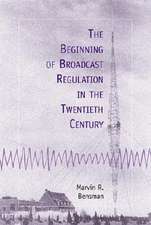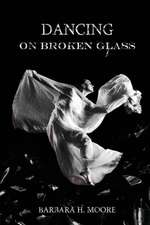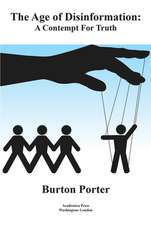Prime-Time Television: A Concise History
Autor Barbara Moore, Marvin R. Bensman, Jim Van Dykeen Limba Engleză Hardback – 29 mar 2006 – vârsta până la 17 ani
Preț: 440.03 lei
Preț vechi: 709.03 lei
-38% Nou
Puncte Express: 660
Preț estimativ în valută:
84.21€ • 87.59$ • 69.52£
84.21€ • 87.59$ • 69.52£
Carte tipărită la comandă
Livrare economică 14-28 aprilie
Preluare comenzi: 021 569.72.76
Specificații
ISBN-13: 9780275981426
ISBN-10: 0275981428
Pagini: 320
Dimensiuni: 156 x 235 x 30 mm
Greutate: 0.64 kg
Editura: Bloomsbury Publishing
Colecția Praeger
Locul publicării:New York, United States
ISBN-10: 0275981428
Pagini: 320
Dimensiuni: 156 x 235 x 30 mm
Greutate: 0.64 kg
Editura: Bloomsbury Publishing
Colecția Praeger
Locul publicării:New York, United States
Notă biografică
Barbara Moore is Professor in the College of Communiacations, University of Tennessee. She co-authored the textbook Radio, TV, and Cable Programming (Iowa State University Press, 1994)Marvin R. Bensman is Professor at the University of Memphis, a member of the board of the Broadcast Education Association, and the author of The Beginning of Broadcast Regulation in the 20th Century (MacFarland, 2000).Jim van Dyke teaches at Marian College in Milwaukee, and has published television criticism in various journals.
Cuprins
IntroductionThe Heritage of Radio Programming (1927-1947)The Experimental Days of Television Programming (1939-1947)Finding an Audience (1948-1952)The Rise and Fall of Live Drama and Quiz Shows (1953-1959)Detectives, Cowboys, and Happy Families (1960-1969)Controversy in Prime Time (1970-1984)Changes in Competition (1996-2005)ConclusionAbbreviationsBibliography
Recenzii
Barbara Moore, Marvin R. Bensman, and Jim Van Dyke have cobbled together a compendium of thoroughly researched evidence that America's top medium for news and information got to be No. 1 for prime-time reasons. The programs, the regulations and the history of television, accompanied by a generous collection of photographs, combine for an interesting addition to the shelves of TV buffs anywhere.
Organized chronologically, this text examines trends in the prime- time programming of the broadcast networks from its roots in 1920s radio to present day offerings. Writing as both academics and fans, Moore and co-authors discuss all of the major technical, aesthetic, and cultural developments in the medium. Sidebars cover such topics as the quiz show scandals and the introduction of the three-camera filmed sitcom.
[P]rovides a complete and accessible understanding of the media medium of television through the historical and modern study of sitcoms, dramas, and other prime-time television particulars. Delving deep into the intricacies of American popular culture and the influential role played by many television shows, Prime-Time Television features a scholarly analysis of the shows, producers, genres, trends, and ideals behind various influential television productions. A seminal contribution to university level Popular Culture reference collections, Prime-Time Television is very strongly recommended reading.
Well-written and clearly and intelligently laid out, this book's greatest strength for high-school researchers is the historically grounded contrasting of radio with television for students unaware of the similarities between the two. This work best serves those concerned with the macro-level of broadcast entertainment, rather than the micro-level of details about specific programs.
Organized chronologically, this text examines trends in the prime- time programming of the broadcast networks from its roots in 1920s radio to present day offerings. Writing as both academics and fans, Moore and co-authors discuss all of the major technical, aesthetic, and cultural developments in the medium. Sidebars cover such topics as the quiz show scandals and the introduction of the three-camera filmed sitcom.
[P]rovides a complete and accessible understanding of the media medium of television through the historical and modern study of sitcoms, dramas, and other prime-time television particulars. Delving deep into the intricacies of American popular culture and the influential role played by many television shows, Prime-Time Television features a scholarly analysis of the shows, producers, genres, trends, and ideals behind various influential television productions. A seminal contribution to university level Popular Culture reference collections, Prime-Time Television is very strongly recommended reading.
Well-written and clearly and intelligently laid out, this book's greatest strength for high-school researchers is the historically grounded contrasting of radio with television for students unaware of the similarities between the two. This work best serves those concerned with the macro-level of broadcast entertainment, rather than the micro-level of details about specific programs.
